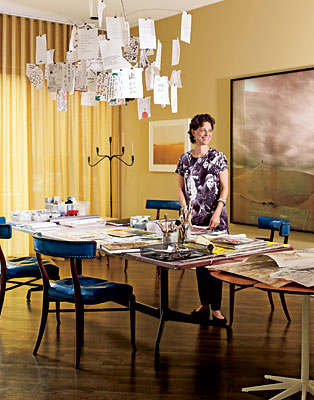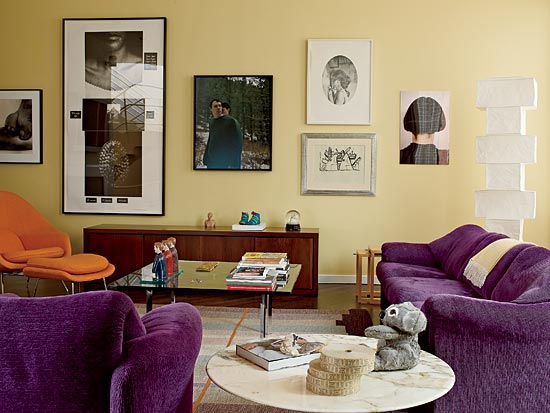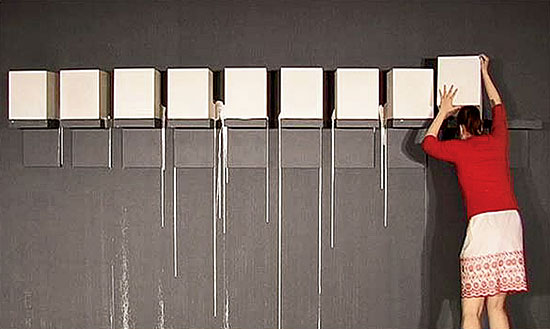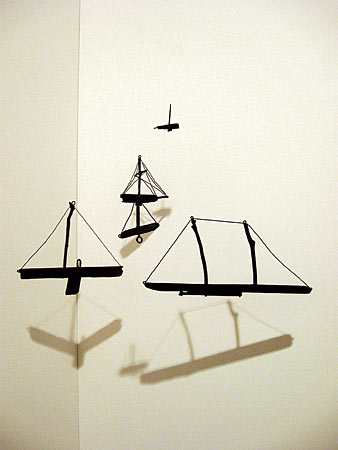
Gilford uses her dining room mostly as an art studio. She inherited the double-pedestal Herman Miller table with the house. The Petal table is by Richard Schultz, the chairs by T.H. Robsjohn-Gibbings, the mobile-like light fixture by Ingo Maurer.
PATTI GILFORD
Art Consultant
A graduate of the Rhode Island School of Design, Gilford has some 30 years of experience as a gallery director and art advisor. She helps develop collections for large and small homes, businesses, and institutions.
Taste in art (then) When I was first out of art school, ’70s minimalism Now Chicago regionalist painting Favorite color Orange First major art purchase Jeanne Dunning piece titled “Head 2” Favorite off-the-radar local exhibit space Co-Prosperity Sphere in Bridgeport Music you’re loving Youssou N’Dour Go-to store for clothes Dovetail in west town Favorite Chicago building The Rookery Favorite restaurant Balsan at the Elysian (I did the art program there—and it’s a great restaurant!) Favorite gallery in The Art Institute The Modern European Art Collection in the Modern Wing One of your favorite exhibitions at the Museum of Contemporary Art The Rudolf Stingel show in 2007 Artist you’d like to have dinner with Chicagoan Theaster Gates, a self-described “sculptor, trickster, and preacher”
Even the most self-assured decorators sometimes freeze when it comes to buying original art—it can be expensive, and it can make or break an interior. Enter the professional art consultant. Patti Gilford is just such a person; she and her team buy, sell, and install art for major corporations and nonprofit organizations, interior designers and architects, and savvy collectors through her firm, Patti Gilford Fine Arts.
Gilford has worked with Jessica Lagrange, John Cannon, Perkins + Will, Kathy Taslitz, and other architects and designers to help their clients start and add to art collections. We recently chatted with her about choosing, buying, and living with art, and how it relates to interior design.
Do you approach art as an investment or as something to enjoy?
There is always a potential for the value of a piece to increase, but it is not a solid reason in and of itself for purchasing a piece. Trust your instinct—go for pieces that you have an intellectual or emotional reaction to that is not easily dismissed. We often recommend artists who have a proven track record, museum shows, and gallery representation, but we keep an open mind to discovering new artists.
Experts always advise to buy what you love. What if I don’t know what I love?
People can’t always articulate what they like. They can articulate “Monet” or “Impressionism,” but some don’t know what that means. People will say, “I really like edgy.” But then we show them something edgy and they are thrown. It’s a lot like interior design, when someone says, “I like contemporary.” What exactly does that mean?
So how do I start?
Look at a lot of pictures. We have a portfolio with a ton of images. Get a gallery guide and hit the streets. There are openings nearly every Friday evening. There are tons of not-for-profits, too.
I hate to ask “What sort of painting will work with my sofa?” But what sort of painting will work with my sofa?
It’s not that we let the materials and colors and finishes of an interior determine the art, but there are a lot of people who just want a really harmonious living environment. They put a lot of thought and consideration into their interior design and they want a work with the right scale, for instance. They want something, depending on their lighting conditions, that they can see. Where it’s sited in their house is important. If a work is behind a sofa and it’s really detailed, there’s a chance you’ll miss something in the viewing of it. We’ll instead site it in a corridor area where you can have a more intimate interaction with it.
Photograph: Andreas Larsson

Gilford walks the talk. Her living room holds a collection of mid-century furniture classics and international art, including an Akari light sculpture (far right) by Isamu Noguchi.
How’s the market right now?
Gallerists and artists are hurting, so discounting is steep. But the good galleries have held their prices. They have a rhyme and reason for their pricing. The ones that have been arbitrary are discounting.
How can I know if a piece of art is fairly priced?
There are databases such as the one on artnet.com that have statistics and compilations of market prices over the past ten years. These are mostly based on auctions but it’s a good way to see what the market is. A lot of artists aren’t on there, however, so you might have to search for similar artists and genres. We do a lot of Googling to find and research artists.
That sounds a lot like looking at comparables in the real estate market.
It’s like any other commodity that’s traded—real estate, stocks, gold. And the art market has outperformed the Standard & Poor’s index historically.
Is it better to buy a small piece of real art or save up until you can buy a piece that makes a real impact?
Do both! I love small works. I am never unhappy with or without a spot to put them.
Do you advise people to mix media, such as drawing, photography, and painting?
Mixing media is exciting. However, there’s nothing wrong with collecting one medium. It is all a matter of the integrity of the individual works, not necessarily if they “go” together. If they are going to hang in the same vicinity, we would advise that they have a dialogue together.
Can I afford you?
We have clients with a $5,000 budget. I buy works ranging from $500 to $1 million.
CONTACT Patti Gilford Fine Arts, 325 W. Huron St., 312-951-9472, pattigilford.com
NEXT: Patti Gilford’s Three to Watch »
Photograph: Andreas Larsson
Three to Watch

1 Kate Gilmore
“I’m impressed with how Kate marries art history and gender politics in her work.”

2 Peter Liversidge
“His work has a serious conceptual bent that is imbued with humor and playfulness.”

3 Justin Cooper
“I originally saw Justin’s work through my colleague Katie Fizdale. He is represented by Monique Meloche Gallery.”
Photography: (Liversidge) John Mckenzie, (Cooper) courtesy Monique Meloche Gallery


